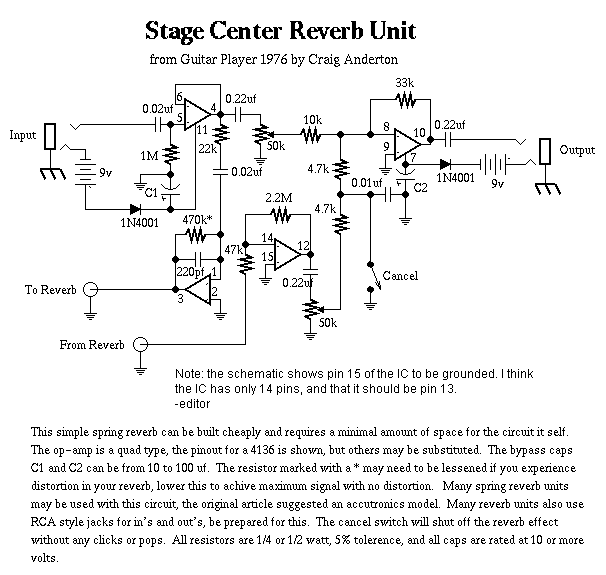bergmann disney
Member
hi prodigy folks, i am new to this board, and not a very experienced electonician. anyway i am trying to uplift my skills, develloping little ideas without pretention. and i have to mention that i never lived in an english speaking country so please fogive my english 
by now, i want to draw a schematic for a reverb unit/guitar pedal without any digitizing of the audio signal. in fact, more than drawing it from A to Z, i am trying to upgrade this spring reverb schematic :

http://www.montagar.com/~patj/screverb.gif
the main problem that i have is that, as far as i am aware, reverb predelay is fixed and dependent of the spring properties. so i want to put a spring with very short "intern" predelay, and put an analogue deelay line before sending signal to the imp adapting opamp circuit that's before "send to spring" jack output.
while reserching, i found about analogue deelay chips, called BBDs. so here is my question : has anyone experienced working with these? do anyone know a simple schematic that would have a good audio frequency response?
but maybe someone knows a better way to do what i want without the use of digital... it's kind of a chalenge i ask myself
thanks a lot to thoose who will kindly spend time answering/helping me
by now, i want to draw a schematic for a reverb unit/guitar pedal without any digitizing of the audio signal. in fact, more than drawing it from A to Z, i am trying to upgrade this spring reverb schematic :

http://www.montagar.com/~patj/screverb.gif
the main problem that i have is that, as far as i am aware, reverb predelay is fixed and dependent of the spring properties. so i want to put a spring with very short "intern" predelay, and put an analogue deelay line before sending signal to the imp adapting opamp circuit that's before "send to spring" jack output.
while reserching, i found about analogue deelay chips, called BBDs. so here is my question : has anyone experienced working with these? do anyone know a simple schematic that would have a good audio frequency response?
but maybe someone knows a better way to do what i want without the use of digital... it's kind of a chalenge i ask myself
thanks a lot to thoose who will kindly spend time answering/helping me


